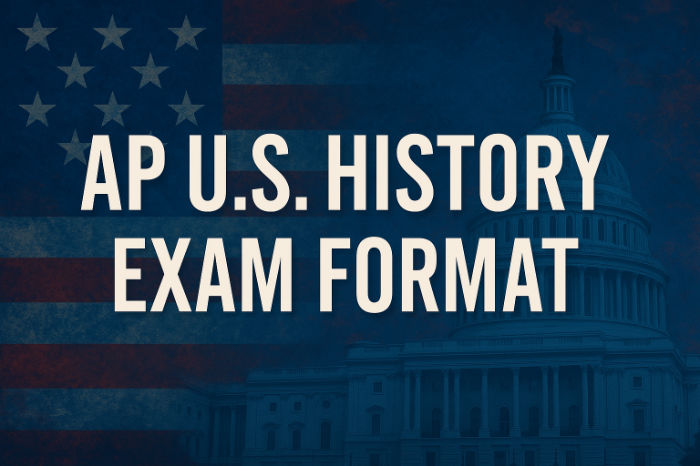AP US History Exam Format
Learn about the AP U.S. History exam structure, including multiple-choice, short-answer, and free-response sections, timing, scoring, and preparation strategies.

The Advanced Placement (AP) U.S. History exam, commonly known as APUSH, is a 3-hour 15-minute test that assesses students' mastery of U.S. history knowledge and skills. It is organized into two sections: a multiple-choice/short-answer section and a free-response section (each divided into two parts). As of 2025, the AP U.S. History exam is administered in a fully digital format via the College Board's Bluebook app. Below is an up-to-date breakdown of the exam structure, including timing and question types, followed by tips on how to prepare for each part.
Exam Structure and Sections
| Section | Number of Questions | Time | Exam Weight | Format |
|---|---|---|---|---|
| Section I Part A: Multiple-Choice | 55 questions | 55 minutes | 40% | Sets of 3-4 questions based on sources |
| Section I Part B: Short-Answer | 3 questions | 40 minutes | 20% | Brief written responses with 3 parts each |
| Section II Part A: Document-Based Question | 1 question | 60 minutes (15-min reading period) | 25% | Essay using 7 provided documents |
| Section II Part B: Long Essay | 1 question (choose 1 of 3) | 40 minutes | 15% | Thesis-driven essay with specific evidence |
Multiple-Choice (Section I Part A): 55 questions · 55 minutes · 40% of exam score. Questions come in sets of 3–4 based on one stimulus (a primary/secondary source, image, chart, etc.). You'll analyze the source and apply your historical knowledge.
Short-Answer Questions (Section I Part B): 3 questions · 40 minutes · 20% of exam score. Each SAQ has three parts (a, b, c) requiring brief written answers. The first two questions include sources and focus on 1754–1980. For the third, you choose between two prompts (one earlier period, one later period). All parts must be answered in complete sentences (no outline or bulleted answers), but you do not need a thesis or intro.
Document-Based Question (Section II Part A): 1 question · 60 minutes (includes 15-min reading period) · 25% of score. You'll get seven documents about a historical topic and write an essay using the documents and your own knowledge to address the prompt. The APUSH DBQ focuses on the period 1754–1980.
Long Essay (Section II Part B): 1 question (choose 1 of 3) · 40 minutes · 15% of score. You'll pick one of three essay prompts, all on the same theme but different time periods. You must develop a clear thesis-driven essay with specific evidence. Unlike the DBQ, no documents are provided for the long essay.
Recent Updates: The APUSH exam format above has been in place since 2018 (when the number of SAQs was reduced from four to three). The most recent change is that the exam is now digital in 2025, but the structure, timing, and content coverage remain the same. Make sure to practice in the Bluebook testing app before exam day so you're comfortable with the interface.
Tips for Multiple-Choice Questions
Answer Every Question: There's no penalty for wrong answers on AP exams, so never leave a question blank. Always take your best guess if you're unsure.
Pace Yourself: You have 55 minutes for 55 questions. Aim for about a minute per question. If you're stuck, eliminate any choices you can and then guess, or mark it and move on – but return to it if time permits.
Read Stimuli Carefully: Each set of questions is based on a stimulus (text, image, map, etc.), so pay close attention to what it says and who/when it's from. Use that context to eliminate answers that don't fit.
Tips for Short-Answer Questions (SAQs)
Be Direct and Specific: Answer each part of the SAQ (a, b, c) directly. In a few sentences, state your answer and include a specific example or piece of evidence to support it. For instance, if asked for one cause of an event, name the cause and provide a concrete detail about it. Make sure to attempt each part – a partial answer is better than leaving it blank.
Keep Answers Concise: You don't need an introduction or conclusion – just jump into answering each part. Use complete sentences and make them count. Aim for 2–4 sentences per part that clearly address the question. Clarity and accuracy are more important than length.
Tips for the Document-Based Question (DBQ)
Use the Reading Period to Plan: Take the first 15 minutes to read all 7 documents and plan your approach. Understand the main idea of each document and why it was created (source context). Group the documents into 2–3 buckets for your body paragraphs (e.g. political, social, economic factors) or however you will structure your argument. Jot down a tentative thesis and an outline of your points – this will leave you about 45 minutes to write your essay.
Incorporate Documents and Outside Evidence: As you write, use evidence from most of the documents to support your argument. Explain how each piece of evidence supports your thesis. Also include at least one additional piece of relevant historical information not in the documents (outside knowledge) to show a deeper understanding of the topic.
Tips for the Long Essay Question (LEQ)
Plan and Develop a Thesis: Spend a few minutes choosing the prompt you feel most confident about and outlining your essay. Jot down a thesis statement that directly answers the question and previews your main points. A focused thesis addressing all parts of the prompt will guide a coherent essay.
Support with Specific Evidence: In the body paragraphs, use specific historical examples to back up your points. Start each paragraph with a clear topic sentence and explain how your evidence supports your thesis. If the prompt involves a historical thinking skill (like comparison or causation), be sure to address it explicitly in your analysis. Write for the full 40 minutes so you can cover everything asked.